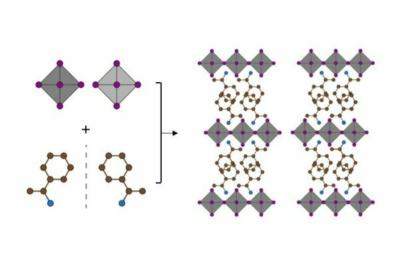Two Eindhoven University of Technology researchers, Shuxia Tao and Nikolay Kosinov, have received an ERC Consolidator Grant worth 2 million euros from the European Research Council (ERC). Tao will research the chirality of materials with perovskites, and Kosinov will focus on carbon-based catalysts.
Schematic representation of chiral material structures. Image credit: TU/e, Shuxia Tao
Shuxia Tao, a Professor of Computational Materials Physics at the Department of Applied Physics and Science Education, studies semiconductors such as perovskites. During Tao’s research, she noted that many materials, both organic and inorganic, have chiral properties. She explains: “Chirality refers to a property where objects are mirror images of each other but cannot be superimposed, like our left and right hands. This property is universal in nature, appearing in everything from twisting DNA to the spin of subatomic particles.”
“Chiral perovskites are unique because they act as a bridge between organic and inorganic systems. They can incorporate organic chiral molecules into an inorganic lattice, which offers excellent optoelectronic properties. This combination creates a unique platform to study the intriguing properties of chirality in a highly controlled way,” says Tao.
“When chiral systems interact with electron spin, a phenomenon called Chiral-Induced Spin Selectivity (CISS) results. This effect allows chiral molecules to filter electrons based on their spin. Electrons, acting like tiny magnets, can attract chiral molecules of a specific handedness if their spins are aligned.”
“These phenomena have significant implications, ranging from more efficient electronics to safer drug design. Researchers have recently proposed that the CISS effect might explain why biological systems are inherently chiral.”
Current models cannot accurately predict chiral material behavior. This is why Tao will study perovskites to create accurate theoretical models in a unified framework. This will help scientists from different fields, both in physics and in (bio)chemistry, to predict chiral (quantum) behavior quantitatively.
Tao: “If we can fully understand how chirality affects the behavior of perovskite, which is a material we know very well, we can apply these insights to many other materials. Our preliminary research, which we started two years ago, indicates we’re on the right path.”
“Chiral perovskites are incredibly versatile. We can enhance chirality and charge transfer by adjusting their dimensionality and chemical compositions, unlocking new physics and functionalities. As a result, these materials hold great promise.”
“For the development of innovative optoelectronics as well as reshaping our understanding of chirality. Their potential impact extends to fields like renewable energy and drug design, and perhaps, they could even bring us closer to solving the mystery of the origins of life.”




